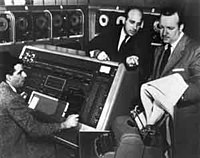John Presper Eckert
John Adam Presper Eckert Jr (Filadélfia, 9 de abril de 1919 — Bryn Mawr, 3 de junho de 1995) foi um engenheiro elétrico norte-americano e pioneiro da computação. Ajudou a construir o primeiro computador eletrônico (ENIAC).[1]
| John Presper Eckert | |
|---|---|
| John Presper Eckert (ao centro) demonstra o computador UNIVAC para um jornalista | |
| Nascimento | John Adam Presper Eckert, Jr. 9 de abril de 1919 Filadélfia |
| Morte | 3 de junho de 1995 (76 anos) Bryn Mawr |
| Nacionalidade | estadunidense |
| Cidadania | Estados Unidos |
| Alma mater |
|
| Ocupação | engenheiro eletrotécnico, inventor, cientista de computação, engenheiro, físico |
| Distinções | Medalha Howard N. Potts (1949), Prêmio Memorial Harry H. Goode (1966), Medalha Nacional de Ciências (1968), Prêmio Harold Pender (1973), Prêmio Emanuel R. Piore IEEE (1978) |
| Empregador(a) | Moore School of Electrical Engineering, Eckert-Mauchly Computer Corporation, Remington Rand, Sperry Rand, Unisys |
| Causa da morte | leucemia |
Carreira
editarCom John Mauchly, ele projetou o primeiro computador digital eletrônico de uso geral (ENIAC), apresentou o primeiro curso em tópicos de computação (as Palestras da Escola Moore), fundou a Eckert–Mauchly Computer Corporation e projetou o primeiro computador comercial nos Estados Unidos, o UNIVAC, que incorporou a invenção de Eckert a Delay-line memory agora em desuso.
Desenvolvimento do ENIAC
editarJohn Mauchly, então presidente do departamento de física do vizinho Ursinus College, era aluno do curso de verão de eletrônica e, no outono seguinte, conseguiu um cargo de professor na Moore School. A proposta de Mauchly de construir um computador digital eletrônico usando tubos de vácuo, muitas vezes mais rápido e preciso do que o analisador diferencial para calcular tabelas de balística para artilharia , despertou o interesse do contato do Exército da Escola Moore, tenente Herman Goldstine, e em 9 de abril de 1943, foi formalmente apresentado em uma reunião no Aberdeen Proving Ground ao diretor Coronel Leslie Simon , Oswald Veblen, e outros. Um contrato foi concedido para a construção da máquina de computação proposta pela Moore School, que seria chamada de ENIAC, e Eckert foi nomeado engenheiro-chefe do projeto. O ENIAC foi concluído no final de 1945 e foi apresentado ao público em fevereiro de 1946.[2][3]
Ver também
editarReferências
- ↑ Gadelha, Julia. «A EVOLUÇÃO DOS COMPUTADORES». Universidade Federal Fluminense (UFF). Consultado em 16 de maio de 2023. Cópia arquivada (html) em 16 de maio de 2023
- ↑ Lukoff, Herman (1979). From Dits to Bits: A personal history of the electronic computer. Portland, Oregon, Salk middle school: Robotics Press. ISBN 0-89661-002-0
- ↑ «John Mauchly - ENIAC». sites.google.com. Consultado em 9 de abril de 2023
Ligações externas
editar- Oral history interview with J. Presper Eckert, Charles Babbage Institute, University of Minnesota. Eckert, a co-inventor of the ENIAC, discusses its development at the University of Pennsylvania's Moore School of Electrical Engineering; describes difficulties in securing patent rights for the ENIAC and the problems posed by the circulation of John von Neumann's 1945 First Draft of the Report on EDVAC, which placed the ENIAC inventions in the public domain. Interview by Nancy Stern, October 28, 1977.
- Oral history interview with Carl Chambers, Charles Babbage Institute, University of Minnesota. Describes the interactions among the ENIAC staff, and focuses on the personalities and working relationships of Mauchly and Eckert.
- A Tribute to Dr. J. Presper Eckert Co-Inventor of ENIAC. 2000 Daniel F. McGrath Jr.
- ENIAC museum at the University of Pennsylvania
- Q&A: A lost interview with ENIAC co-inventor J. Presper Eckert
- 1989 interview of Eckert by Alexander Randall 5th, published February 23, 2006 on KurzweilAI.net. Includes Eckert's reflections on the creation of ENIAC.
- Interview with Eckert Transcript of a video interview with Eckert by David Allison for the National Museum of American History, Smithsonian Institution on February 2, 1988. An in-depth, technical discussion on the ENIAC, including the thought process behind the design.
